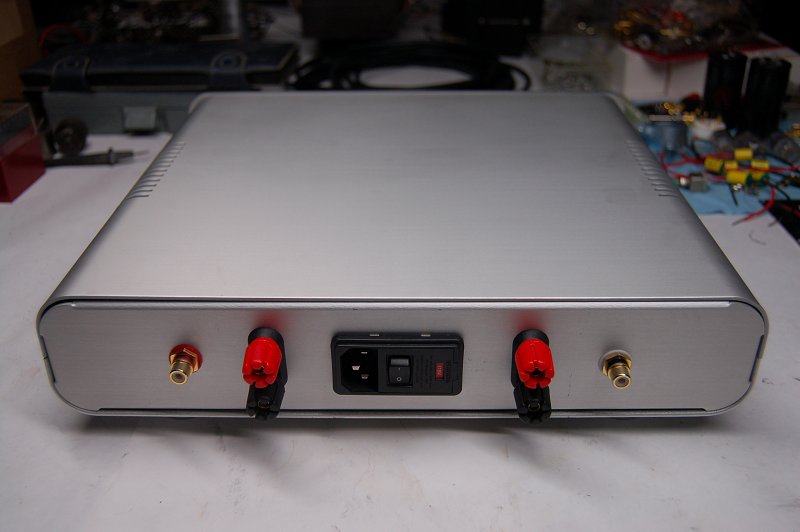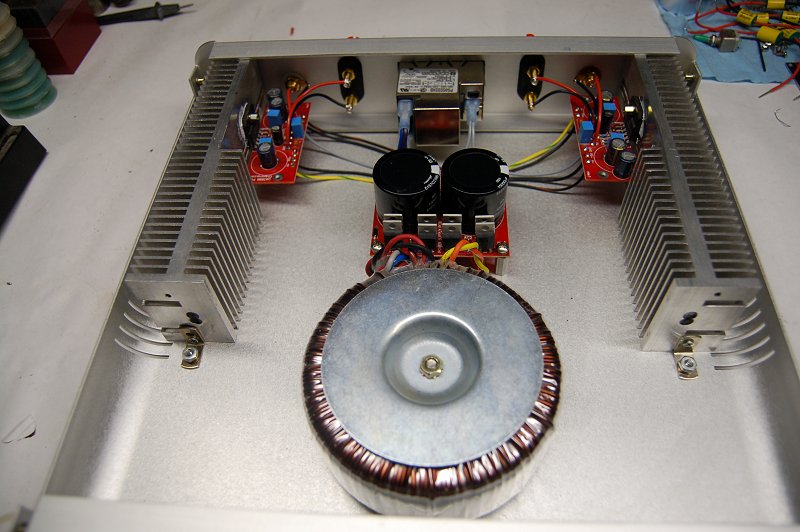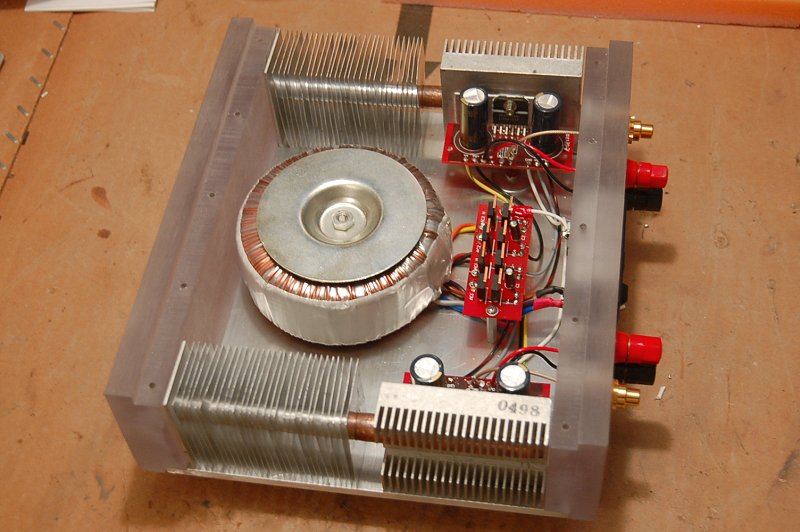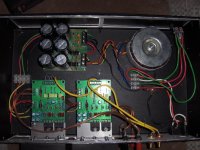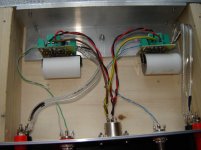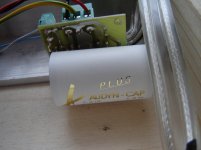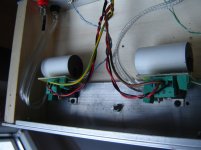Hi There
Your amp looks great. I am glad it sounds good as well. May I ask you a couple of questions as I am about to construct a Peter Daniel chip amp.
The 2 black ceramic caps which I presume are there to cut down switching on clicks? What value and voltage have you used?
Secondly the red caps shown on underside of the rectifier board are they Snubbers? Again what value have you used?
I would greatly appreciate this info before I start I want to completely try to understand what I am doing.
Many Thanks
dh
Your amp looks great. I am glad it sounds good as well. May I ask you a couple of questions as I am about to construct a Peter Daniel chip amp.
The 2 black ceramic caps which I presume are there to cut down switching on clicks? What value and voltage have you used?
Secondly the red caps shown on underside of the rectifier board are they Snubbers? Again what value have you used?
I would greatly appreciate this info before I start I want to completely try to understand what I am doing.
Many Thanks
dh
DH
Who are you talking to?
I dont see black ceramics on any recent pics but caps under a rectifier board would be snubbers and most likely if red they are Wima film caps of .1uf.
Voltage for any caps should be a minimum of 25% higher than the max voltage they will see. DC voltage will be 1.4 times higher than the AC voltage from the transformers secondaries.
Uriah
Who are you talking to?
I dont see black ceramics on any recent pics but caps under a rectifier board would be snubbers and most likely if red they are Wima film caps of .1uf.
Voltage for any caps should be a minimum of 25% higher than the max voltage they will see. DC voltage will be 1.4 times higher than the AC voltage from the transformers secondaries.
Uriah
Capacitor Questions
Hi There.
Your amp looks great. I am glad it sounds good as well.
May I ask you a couple of questions as I am about to construct a Peter Daniel chip amp.
The 2 black Capacitors connected across the mains input terminal strips which I presume are there to cut down switching on clicks? What value and voltage have you used?
Secondly the red caps shown on underside of the rectifier board are they Snubbers? Again what value have you used?
I would greatly appreciate this info before I start I want to completely try to understand what I am doing.
Many Thanks
dh
Hello I just add more juice to my integrated chip-amp.I had two "extra" Mundorf caps. so Now it has 20000uf per channel.The sound is wonderful.
Hi There.
Your amp looks great. I am glad it sounds good as well.
May I ask you a couple of questions as I am about to construct a Peter Daniel chip amp.
The 2 black Capacitors connected across the mains input terminal strips which I presume are there to cut down switching on clicks? What value and voltage have you used?
Secondly the red caps shown on underside of the rectifier board are they Snubbers? Again what value have you used?
I would greatly appreciate this info before I start I want to completely try to understand what I am doing.
Many Thanks
dh
Capacitor questions
DH
Who are you talking to?
Hi I was trying to address lanchile;202963 but thanks for replying anyway
I dont see black ceramics on any recent pics but caps under a rectifier board would be snubbers and most likely if red they are Wima film caps of .1uf.
Voltage for any caps should be a minimum of 25% higher than the max voltage they will see. DC voltage will be 1.4 times higher than the AC voltage from the transformers secondaries.
Uriah
Nice case. Where'd you get it?
Side note: The slots appear to be contradictory in the pictures unless the bottom and top slots are off set.
I bought the case (ATI-738U) from ATI Research back in 2007. It has been sitting on a shelf, so I decided to use it for this little weekend project.
The slot difference is an optical illusion. Top and bottom have center slots.
...with heat pipes.
Nice work!

Those "heat pipes" are pieces of hot water radiators.
Cool none the less.
Nice work!
Those "heat pipes" are pieces of hot water radiators.
Cool none the less.
I had no clue. I saw Peter Daniel use some years ago and liked the look. I got these off Ebay. The pig tweak add some bottom end to the music.
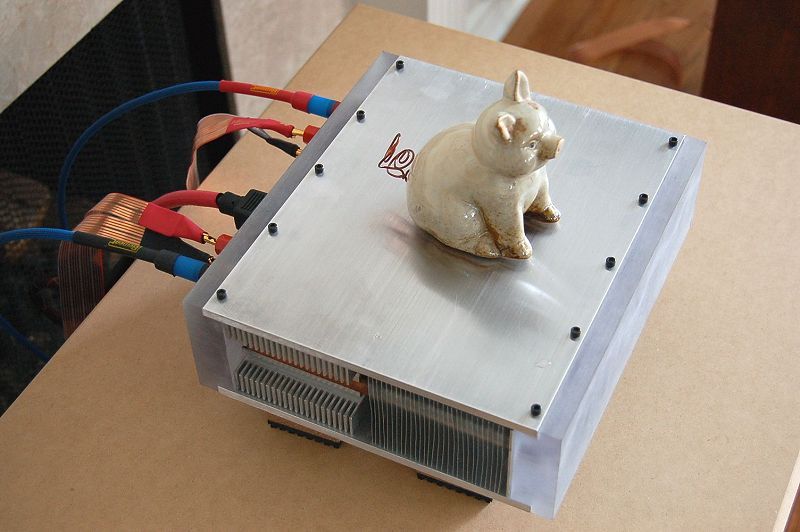
Hey, LOVE your website! Have enjoyed it for over a month. I think AudioFred showed it to me, maybe Sonidos. Anyway I enjoy it and your woodwork is really nice.
We have an audio get together in Texas. Houston. First Saturday in March. Contact me if you would be interested. Its for DIY projects.
I have the same speaker wires. I like them but they are a bit long and they are a bit of a mess when they are to long.
Uriah
We have an audio get together in Texas. Houston. First Saturday in March. Contact me if you would be interested. Its for DIY projects.
I have the same speaker wires. I like them but they are a bit long and they are a bit of a mess when they are to long.
Uriah
Since i registered a few days ago, it's only fair to show my first amp.
It's a BPA-200 using four LM3886T's in bridged mode.
Pretty crappy way to get around not fitting in the board. But hey it works.
Looks like a sine
It's a BPA-200 using four LM3886T's in bridged mode.
An externally hosted image should be here but it was not working when we last tested it.
An externally hosted image should be here but it was not working when we last tested it.
Pretty crappy way to get around not fitting in the board. But hey it works.
An externally hosted image should be here but it was not working when we last tested it.
Looks like a sine
An externally hosted image should be here but it was not working when we last tested it.
LM1875 non inverted
Here is my implementation of LM1875, psu is regulated +/-25V(LT1083) for now, but latter it will get shunt regulator and also new housing. If anyone is interested into the PCB layout it is available HERE.
and also new housing. If anyone is interested into the PCB layout it is available HERE.
Regards Aleš
Here is my implementation of LM1875, psu is regulated +/-25V(LT1083) for now, but latter it will get shunt regulator
Regards Aleš
Attachments
Wow there are some very impressive amps on here.
Mine is no where near as nice looking. I'll put up some pics anyway.
I made the case for it in grade 9, so about 9 years ago. I made the amp itself in grade 11, before that I had LM1875s, 3875s. It's got a pair of LM4780s, each in bridge mode. The power supply is two 24V SMPS, they are each rated at 3.5A. But they feed the LM4780s with no problems. Although I usually listen at fairly low levels, so it rarely needs anywhere near 3.5A. I'm very happy with this amp since there is absolutely no hum. I get more noise from my hard drive seeking than from hum. And even that is barely audible. My other chipamps have considerably more hum. Oh the little transformer is for the fans, which I have running off about 7Vdc from a LM317. So they aren't really audible. They aren't really necessary for normal listening, but full tilt the heatsinks get pretty hot without them.
So yeah that's my chipamp contribution.
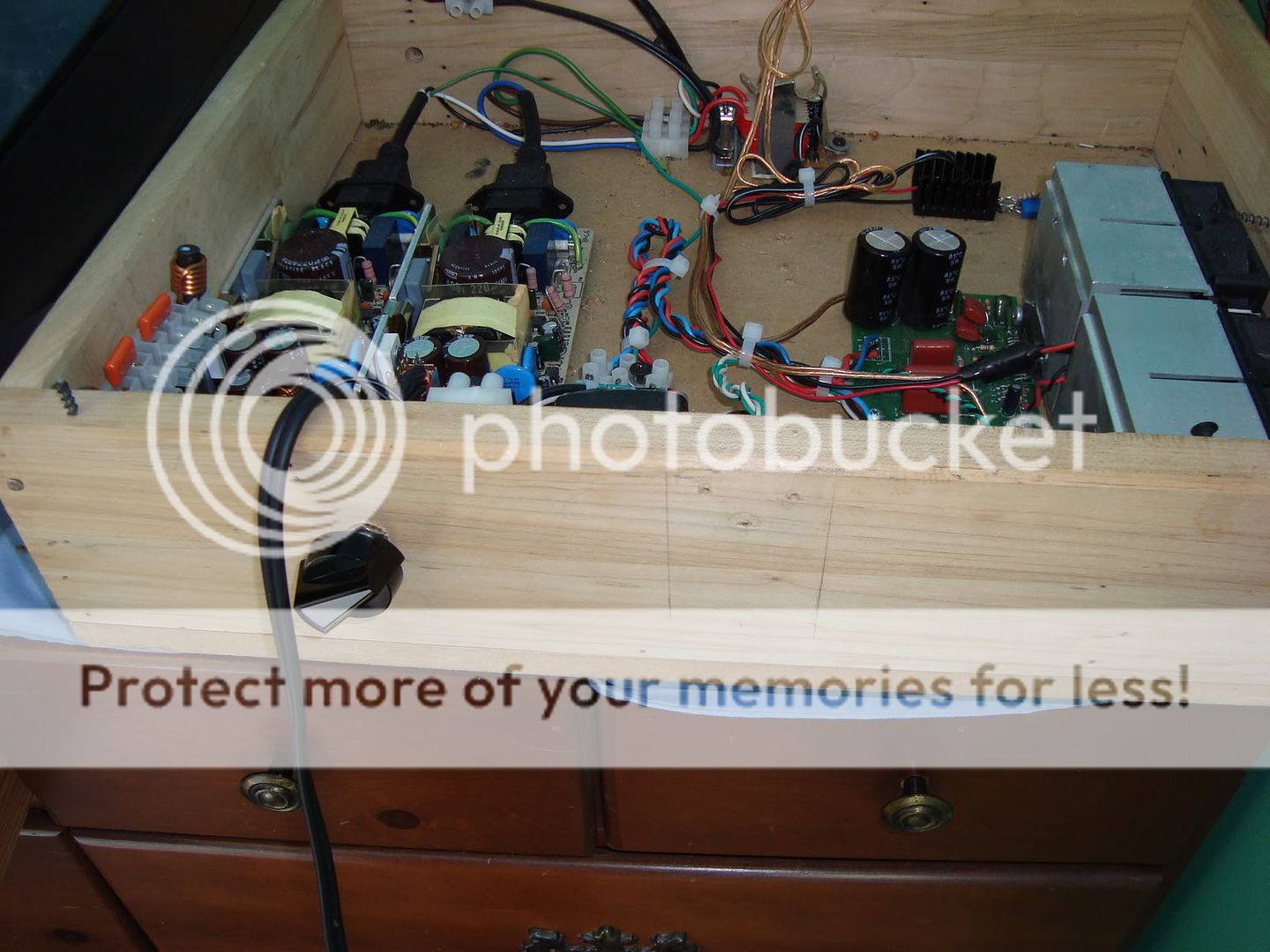
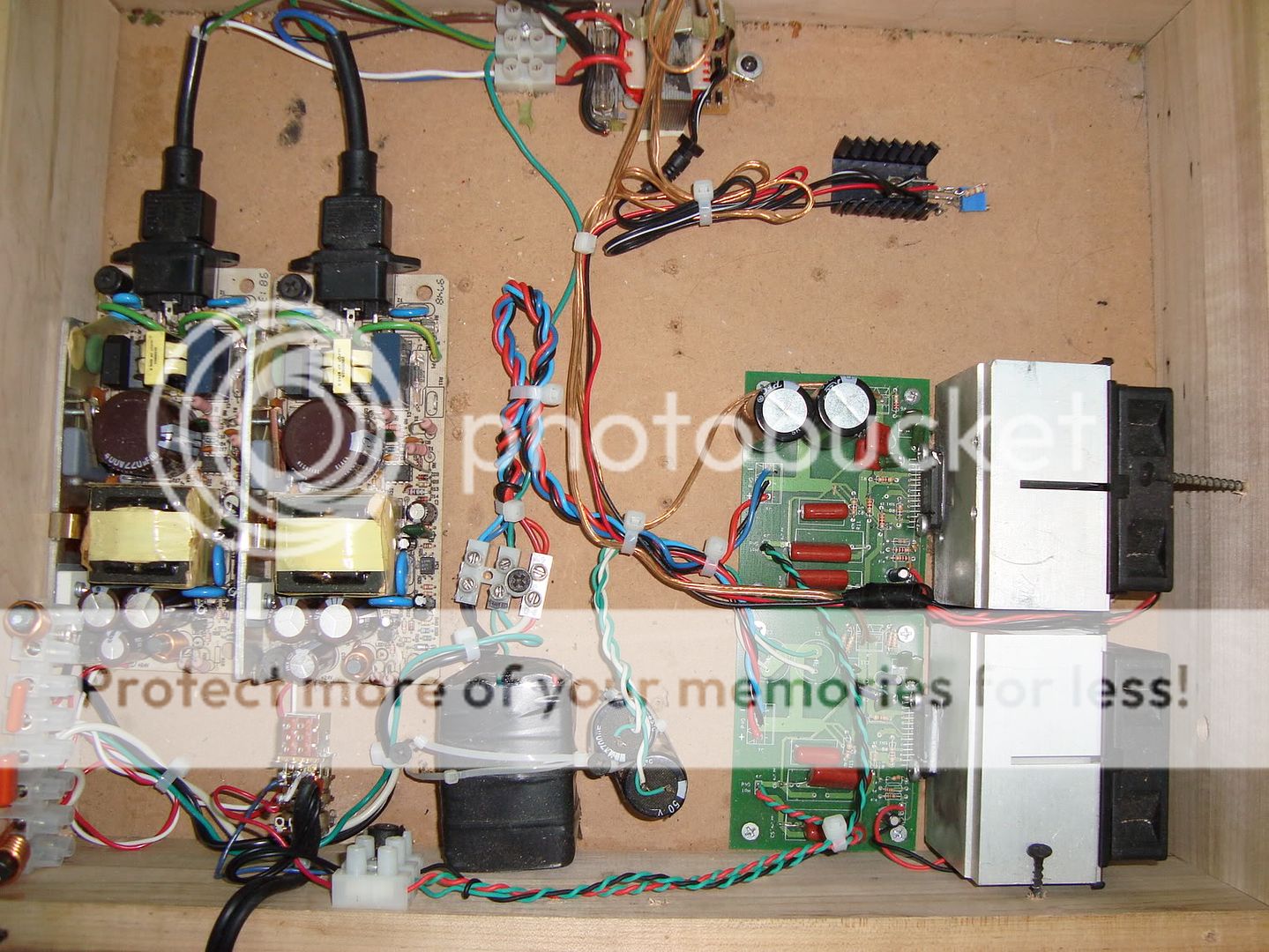
Mine is no where near as nice looking. I'll put up some pics anyway.
I made the case for it in grade 9, so about 9 years ago. I made the amp itself in grade 11, before that I had LM1875s, 3875s. It's got a pair of LM4780s, each in bridge mode. The power supply is two 24V SMPS, they are each rated at 3.5A. But they feed the LM4780s with no problems. Although I usually listen at fairly low levels, so it rarely needs anywhere near 3.5A. I'm very happy with this amp since there is absolutely no hum. I get more noise from my hard drive seeking than from hum. And even that is barely audible. My other chipamps have considerably more hum. Oh the little transformer is for the fans, which I have running off about 7Vdc from a LM317. So they aren't really audible. They aren't really necessary for normal listening, but full tilt the heatsinks get pretty hot without them.
So yeah that's my chipamp contribution.


Here's mine, LM3886 and OPA2134 based. I rebuilt it a couple of months ago on proper PCBs and a decent housing. It has 4 inputs selectable via rotary switch, and -12dB, 0dB and 12dB preamp settings.
Preamplifier:
Overview:
PSU:
Power IC's:
Job done:
Preamplifier:
An externally hosted image should be here but it was not working when we last tested it.
Overview:
An externally hosted image should be here but it was not working when we last tested it.
PSU:
An externally hosted image should be here but it was not working when we last tested it.
Power IC's:
An externally hosted image should be here but it was not working when we last tested it.
Job done:
An externally hosted image should be here but it was not working when we last tested it.
Yet another heatsink-in-a-box!!!
You and most others here need to read-up on how "heatsinks" work.
The heat doesn't just magically disappear (as its name implies), it has to be removed by convection and/or radiation.
Here's mine, LM3886 and OPA2134 based. I rebuilt it a couple of months ago on proper PCBs and a decent housing. It has 4 inputs selectable via rotary switch, and -12dB, 0dB and 12dB preamp settings.
You and most others here need to read-up on how "heatsinks" work.
The heat doesn't just magically disappear (as its name implies), it has to be removed by convection and/or radiation.
Last edited:
Frank,
Its going to be okay for those guys who are enclosing their sinks. The chips dont get very warm to start with and those sinks are plenty big enough even in a non vented area.
I had one in a 18x18x3" space for over half a year with no problem. The sinks were warm to the touch. This was with 24VDC and very efficient speakers. If you are running higher voltage and driving less than efficient speakers you might run into trouble but luckily the LM3886 will tell you they are to hot by literally screaming at you through your speakers.
SPIKE protection.
Uriah
Its going to be okay for those guys who are enclosing their sinks. The chips dont get very warm to start with and those sinks are plenty big enough even in a non vented area.
I had one in a 18x18x3" space for over half a year with no problem. The sinks were warm to the touch. This was with 24VDC and very efficient speakers. If you are running higher voltage and driving less than efficient speakers you might run into trouble but luckily the LM3886 will tell you they are to hot by literally screaming at you through your speakers.
SPIKE protection.
Uriah
You and most others here need to read-up on how "heatsinks" work.
The heat doesn't just magically disappear (as its name implies), it has to be removed by convection and/or radiation.
I do know how the heatsink works and how they should be placed, I'm an EE. In the previous enclosure I had it mounted outside the case with the fins placed vertical. It was never that hot that I cannot keep my fingers on it no matter how loud it was playing, so when I changed the enclosure I did alot of tests to be sure that SPIKE doesn't get into action.
During testing I placed a thermocouple straight on the chips and measured the temperature after playing loud enough to be disturbing. The chips barely reached 60 degrees at a room temperature of 22, whith the enclosure closed. At normal levels the temperature doesn't pass over 35. Actually, here are the results for the measurements:
81dB in listening position, 32C on the chip, 0.85Vrms at amplifier output, around 80mW. Play time: around one hour.
101dB in listening position (nobody complained, lucky me), 58C on the chip, 7.92Vrms at amplifier output, around 8W. Play time: only 15 minutes because it was way too loud for my ears and I couldn't endure more.
Devices used for measurements were a Fluke 187 multimeter borrowed from work and a commercial SPL meter for which I don't recall the name, it was also borrowed.
My speakers are having a sensitivity of 92dB and I actually had to remove the heatsink to hear the first time how the SPIKE sounds like. Yet-another-heatsink-in-a-box does the job very good though. So, thank you for your kind intentions, but I think I have pretty much headroom, heh?
Ratza,
I don't agree with your reasoning, but I do like the fact you did some testing before making that informed decision.
I would like to run my chipamps cooler than you do, but that's just a difference of opinion. We are both entitled to our own opinions and to make our own informed decisions.
I suspect that Frank did not realise how you came to your decision, but I think he was right to point out what he saw and why he said it.
Enclosed heatsinks rapidly increase the ambient temperature inside power amp cases. This practice if not monitored can lead to poor sound and more importantly poor reliability.
Frank,
Don't let this put you off. Your observation was correct, there appeared to be something wrong. What saved the situation was 92dB speakers. 89dB speakers requiring twice the power for the same volume would cause the amp some ill-needed stress. 86dB speakers would be unsuitable.
I don't agree with your reasoning, but I do like the fact you did some testing before making that informed decision.
I would like to run my chipamps cooler than you do, but that's just a difference of opinion. We are both entitled to our own opinions and to make our own informed decisions.
I suspect that Frank did not realise how you came to your decision, but I think he was right to point out what he saw and why he said it.
Enclosed heatsinks rapidly increase the ambient temperature inside power amp cases. This practice if not monitored can lead to poor sound and more importantly poor reliability.
Frank,
Don't let this put you off. Your observation was correct, there appeared to be something wrong. What saved the situation was 92dB speakers. 89dB speakers requiring twice the power for the same volume would cause the amp some ill-needed stress. 86dB speakers would be unsuitable.
- Home
- Amplifiers
- Chip Amps
- Chip Amp Photo Gallery
